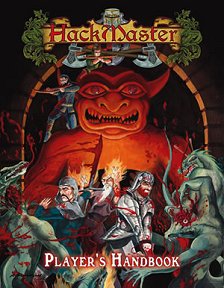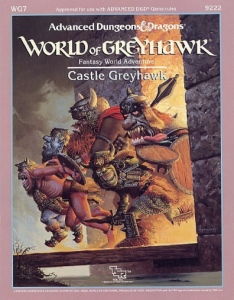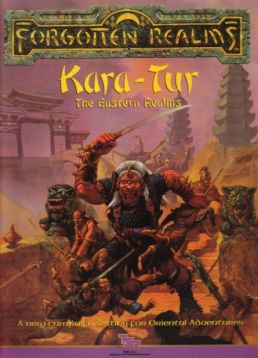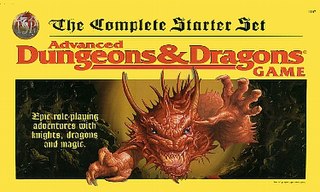
Dungeons & Dragons is a fantasy tabletop role-playing game (RPG) originally created and designed by Gary Gygax and Dave Arneson. The game was first published in 1974 by Tactical Studies Rules, Inc. (TSR). It has been published by Wizards of the Coast, later a subsidiary of Hasbro, since 1997. The game was derived from miniature wargames, with a variation of the 1971 game Chainmail serving as the initial rule system. D&D's publication is commonly recognized as the beginning of modern role-playing games and the role-playing game industry, and also deeply influenced video games, especially the role-playing video game genre.
Forgotten Realms is a campaign setting for the Dungeons & Dragons (D&D) fantasy role-playing game. Commonly referred to by players and game designers as "The Realms", it was created by game designer Ed Greenwood around 1967 as a setting for his childhood stories. Several years later, it was published for the D&D game as a series of magazine articles, and the first Realms game products were released in 1987. Role-playing game products have been produced for the setting ever since, in addition to novels, role-playing video game adaptations, comic books, and the film Dungeons & Dragons: Honor Among Thieves.

Spelljammer is a campaign setting originally published for the Advanced Dungeons & Dragons role-playing game, which features a fantastic outer space environment. Subsequent editions have included Spelljammer content; a Dungeons & Dragons 5th edition setting update was released on August 16, 2022.

TSR, Inc. was an American game publishing company, best known as the original publisher of Dungeons & Dragons (D&D). Its earliest incarnation, Tactical Studies Rules, was founded in October 1973 by Gary Gygax and Don Kaye. Gygax had been unable to find a publisher for D&D, a new type of game he and Dave Arneson were co-developing, so he founded the new company with Kaye to self-publish their products. Needing financing to bring their new game to market, Gygax and Kaye brought in Brian Blume in December as an equal partner. Dungeons & Dragons is generally considered the first tabletop role-playing game (TTRPG), and established the genre. When Kaye died suddenly in 1975, the Tactical Studies Rules partnership restructured into TSR Hobbies, Inc. and accepted investment from Blume's father Melvin. With the popular D&D as its main product, TSR Hobbies became a major force in the games industry by the late 1970s. Melvin Blume eventually transferred his shares to his other son Kevin, making the two Blume brothers the largest shareholders in TSR Hobbies.

HackMaster is a fantasy role-playing game produced by Kenzer & Company. It began as a fictional game, a parody of Dungeons & Dragons played by the characters of the Knights of the Dinner Table comic strip by Jolly R. Blackburn. The characters in the comic began playing fictional HackMaster 3rd Edition, which was updated and published in 2001 as a numerously revised 4th edition. It has been hinted the name of the game was originally changed for copyright reasons.
Richard Baker is an American author and game designer who has worked on many Dungeons & Dragons campaign settings.

The Forgotten Realms Campaign Setting is a role-playing game sourcebook first published by TSR in 1987 for the first edition of the fantasy role-playing game Advanced Dungeons & Dragons that describes the campaign setting of the Forgotten Realms. It contains information on characters, locations and history. Various revised and updated editions have been produced over the years.
Kenzer & Company (KenzerCo) is a Waukegan, Illinois based publisher of comic books, role-playing games, board games, card games, and miniature games.
The flexibility of the Dungeons & Dragons (D&D) game rules means that Dungeon Masters (DM) are free to create their own fantasy campaign settings. For those who wanted a pre-packaged setting in which to play, TSR, Wizards of the Coast (WotC), and other publishers have created many settings in which D&D games can be based; of these, the Forgotten Realms, an epic fantasy world, has been one of the most successful and critically acclaimed settings. Many campaign settings include standard sword and sorcery environments, while others borrow Asian, Central American, swashbuckling, horror and even space-travel themes.

Return to the Keep on the Borderlands is a 1999 adventure module for the Dungeons & Dragons fantasy role-playing game. It is a sequel to the original The Keep on the Borderlands module (B2) from 1979. Both modules were published by TSR, Inc.

Ptolus, subtitled "Monte Cook's City by the Spire", is a fantasy role-playing game campaign setting published by Malhavoc Press in 2006 that details a single city and the dungeons that lie beneath it. Ptolus uses the rules of the third edition of Dungeons & Dragons — the d20 System — under the terms of Wizards of the Coast's Open Game License. At 672 pages, it was the largest D&D supplement that had been published up to that time.
Lenard William Lakofka was an American writer of material for the fantasy role-playing game Dungeons & Dragons. Although never a formal employee of TSR, the company that published Dungeons & Dragons, Lakofka was an influential voice in the development of the game. He was one of the playtesters of the game as it was being developed, an editor of early manuscripts, wrote a widely-read monthly D&D magazine column and two official D&D adventures, and had his home campaign setting of the Lendore Isles incorporated into Gary Gygax's World of Greyhawk Fantasy Game Setting.

Castle Greyhawk is a comedic adventure module for the Dungeons & Dragons fantasy roleplaying game set in the World of Greyhawk campaign setting. The module bears the code WG7 and was published by TSR, Inc. in 1988 for the first edition Advanced Dungeons & Dragons rules.

The Dungeons & Dragons Rules Cyclopedia is a 1991 book published by TSR, Inc., as a continuation of the basic edition of the Dungeons & Dragons fantasy role-playing game, which ran concurrently with Advanced Dungeons & Dragons. Its product designation was TSR 1071.

Dark Sun is an original Dungeons & Dragons (D&D) campaign setting set in the fictional, post-apocalyptic desert world of Athas. Dark Sun featured an innovative metaplot, influential art work, dark themes, and a genre-bending take on traditional fantasy role-playing. The product line began with the original Dark Sun Boxed Set released for D&D's 2nd edition in 1991, originally ran until 1996, and was one of TSR's most successful releases.

Ravenloft: Realm of Terror is a boxed set accessory published in 1990 for the Ravenloft campaign setting for the Advanced Dungeons & Dragons fantasy role-playing game.

Kara-Tur: The Eastern Realms is an accessory and campaign setting for the Advanced Dungeons & Dragons fantasy role-playing game.
David S. Kenzer is a game designer who has worked primarily on role-playing games.

The Dungeons & Dragons Starter Set is a category of companion accessories across multiple editions of the Dungeons & Dragons fantasy role-playing game. In general, the Starter Set is a boxed set that includes a set of instructions for basic play, a low level adventure module, pre-generated characters, and other tools to help new players get started.














